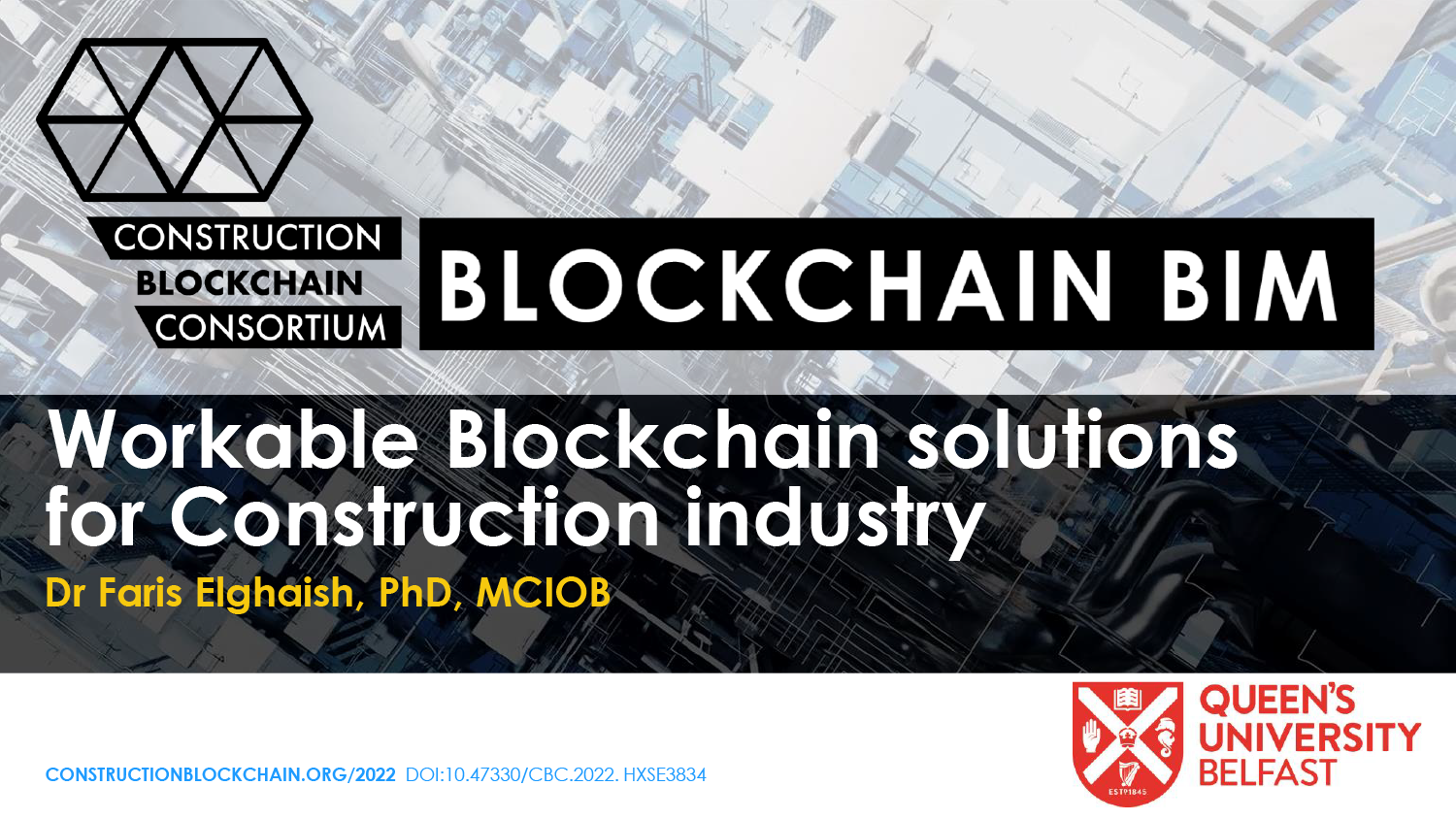Difference between revisions of "Workable Blockchain solutions for Construction industry"
| (2 intermediate revisions by the same user not shown) | |||
| Line 5: | Line 5: | ||
[[Category:Conferences]] | [[Category:Conferences]] | ||
| − | [[CBC 2022]] presentation by [[Faris Elghaish]]. https://doi.org/10.47330/CBC.2022.WAXE7154 | + | [[CBC 2022]] presentation by [[Faris Elghaish]]. https://doi.org/10.47330/CBC.2022.WAXE7154 | Watch [[File:VideoRecord-Icon.png |Left|22px|link=https://youtu.be/uf3Hz8XAm6w]] | [[File:Slides-Icon.png |Left|30px|link=https://www.dropbox.com/s/0d5cx74tdrl4rwp/CBC2022_S4-1_F-Elghaish.pdf?dl=0]] |
| Line 12: | Line 12: | ||
=Abstract= | =Abstract= | ||
| − | + | In my keynote speech at the CBC event in 2022, I presented practical applications of blockchain technology in the construction industry. I discussed my research publications, specifically focusing on a solution that automates risk/reward sharing among IPD core team members using the Introduced IPD blockchain framework. This framework allows for automatic execution of financial transactions by coding the main transactions of IPD projects as functions of the IPD smart contract. The blockchain-based system I introduced automates key financial transactions throughout all project stages, including the Defects Liability Period (DLP). It enables secure and automatic recording and invocation of transactions, reducing the need for third-party involvement. The proposed system also allows non-owner parties to control their financial rights during the DLP based on a pre-agreed endorsement policy, providing evidence of its effectiveness and feasibility in real-life projects. | |
| − | + | Furthermore, I discussed the development of a proactive supply chain management system for vulnerable assets, particularly nuclear power plants, using Blockchain of Things (BCoT). This solution addresses supply chain challenges by automating the monitoring of critical component performance and ensuring zero delays. By leveraging BCoT, the proactive supply chain system links IoT-based evaluation of item requirements with purchasing, implementation, and inventory management tasks. This integration of IoT and blockchain enhances efficiency and reliability in supply chain operations for vulnerable assets. Additionally, I presented the utilization of blockchain in developing a dependent supply chain system through the adoption of Material Requirements Planning (MRP) for prefabricated buildings. This involves the development of interconnected chaincode to automate MRP scheduling. In conclusion, I highlighted the potential of integrating blockchain, Internet of Things, and AI to create predictive blockchain of Things solutions that effectively address fragmentation issues, supply chain delays, and cost overruns in the construction process. My keynote speech emphasized how blockchain technology can transform the construction industry by improving efficiency, transparency, and collaboration. | |
| − | |||
| − | |||
| − | |||
| − | |||
| − | |||
=Keywords= | =Keywords= | ||
| − | [[ | + | [[Blockchain]], [[IoT]], [[Automation]], [[IPD projects]]. |
| − | |||
| − | |||
| − | |||
Latest revision as of 18:34, 22 May 2023
CBC 2022 presentation by Faris Elghaish. https://doi.org/10.47330/CBC.2022.WAXE7154 | Watch
Abstract
In my keynote speech at the CBC event in 2022, I presented practical applications of blockchain technology in the construction industry. I discussed my research publications, specifically focusing on a solution that automates risk/reward sharing among IPD core team members using the Introduced IPD blockchain framework. This framework allows for automatic execution of financial transactions by coding the main transactions of IPD projects as functions of the IPD smart contract. The blockchain-based system I introduced automates key financial transactions throughout all project stages, including the Defects Liability Period (DLP). It enables secure and automatic recording and invocation of transactions, reducing the need for third-party involvement. The proposed system also allows non-owner parties to control their financial rights during the DLP based on a pre-agreed endorsement policy, providing evidence of its effectiveness and feasibility in real-life projects. Furthermore, I discussed the development of a proactive supply chain management system for vulnerable assets, particularly nuclear power plants, using Blockchain of Things (BCoT). This solution addresses supply chain challenges by automating the monitoring of critical component performance and ensuring zero delays. By leveraging BCoT, the proactive supply chain system links IoT-based evaluation of item requirements with purchasing, implementation, and inventory management tasks. This integration of IoT and blockchain enhances efficiency and reliability in supply chain operations for vulnerable assets. Additionally, I presented the utilization of blockchain in developing a dependent supply chain system through the adoption of Material Requirements Planning (MRP) for prefabricated buildings. This involves the development of interconnected chaincode to automate MRP scheduling. In conclusion, I highlighted the potential of integrating blockchain, Internet of Things, and AI to create predictive blockchain of Things solutions that effectively address fragmentation issues, supply chain delays, and cost overruns in the construction process. My keynote speech emphasized how blockchain technology can transform the construction industry by improving efficiency, transparency, and collaboration.

